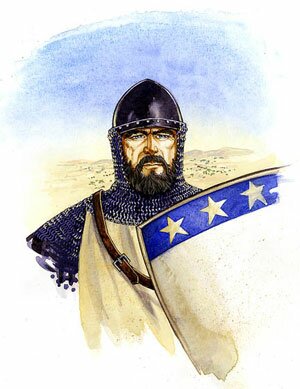The Black Douglas. The very name evokes images of dread. He is said to have had thick black hair and a thick, black beard, but to the English, the name referred strictly to his deeds. Starting immediately after Bannockburn, when Edward II refused to grant recognition to the Scots as an independent nation, James Douglas embarked on a series of border raids, plundering, pillaging, and burning much of the north of England. So dreaded was his name that a rhyme sprang up about him: 
Hush ye, hush ye, little pet ye,
Hush ye, hush ye, do not fret ye,
The Black Douglas shall not get ye.
One famous story tells of a mother consoling her child with the rhyme above. At the final words, a voice behind her said, “At least not tonight.” The Black Douglas had stood behind her in silence, listening to her sing. (To the best of my knowledge, Douglas did neither her nor her child any harm.)
It is hard to imagine that a child’s hobby horse could have any relation to medieval warfare, or a man of such fierce reputation. And yet, it is from the horses ridden by Robert Bruce and the Black Douglas and their men that we get the name hobby horse.
The Irish Hobby is the official name of the breed, developed before the 13th century, and now extinct, though it was used to develop many current breeds, including the Connemara and the Irish Draught. They were smaller horses, sometimes described as more like ponies, whose strength was in being light, agile, and swift. The name, in fact, is believed to come from the French hobin, which is said to come in turn from the Gaelic obann, meaning swift.
The hobbin’s speed came, in part, from being well suited to the bogs, forests, and hills of Ireland and Scotland. Being light and agile allowed it to move easily through such places, where the large English warhorse was at a disadvantage. Even in such rough conditions, hobelars–the men who rode the hobbins–could cover an astonishing 60 to 70 miles a day, allowing them to make the lightning strike-and-retreat raids across the English border for which James Douglas was especially famed.
Unlike the warhorse, trained for battle, the hobbin was essentially a mode of transport. The Scots typically rode in fast, dismounted to fight on foot, and rode out again. The humble hobbin, however, might claim some credit for the Scots frequent ability to outfight much larger armies. Imagine how it might have been:

The Connemara Pony, a breed believed to be similar to the hobbins ridden by James Douglas and his men.
Silhouetted by the moon, the first English charger stumbled at the top of the hill, struggling to keep its footing under a thousand pounds of knight, armor, and weapons. The Scots loosed a storm of arrows, felling knights as they picked their way down the slope.
One armor-covered stallion burst onto the moor. Mud sucked at its fetlocks, dragging it down. It lifted its nose, bared its teeth with an angry scream, yanking its leg. Two more knights reached the bog. The Scots loosed another volley; three mired horses and riders went down.
None of it is quite what we think of today when we see children skipping with their hobby horses to the jovial strains of the William Tell Overture.
![]() Tweet This Post
Tweet This Post
Tags: hobbin, hobby horse, hobelar, James Douglas, raids on England



Definitely an excellent blog post about the subject, keep up the great work and also I hope to examine more of your stuff in the longer term.
Hi, Jackson,
thank you!
Laura
hey great information your site contains will return when I have time to read more.
great article, i just finished bookmarking it to regularly check it. i’d love to check on future articles. how can i set up the rss reader again? thanks!
Thank you so much for creating this post. I have added your blog to my Google Reader. Have a excellent day.
I just placed this article on facebook account. it’s a very interesting read for anyone.